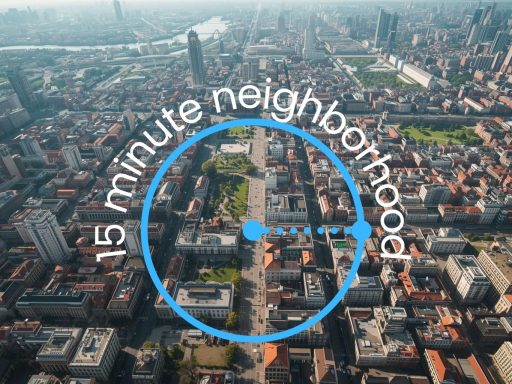Understanding Hyperlocal Data
In today’s information-rich world, data is often hailed as the most valuable asset. But not all data is created equal. Hyperlocal data, in particular, has emerged as a transformative tool for individuals and professionals navigating the world of real estate. It refers to highly specific data tied to a narrowly defined geographic area, often within just a few blocks or even centered around a single address within a 1-2 mile radius. Unlike city, ZIP code or even neighborhood-level data, hyperlocal insights paint a vivid picture of what life is actually like on street level. This level of detail provides a clearer, more personal perspective that has practical implications for a wide range of users—from homebuyers and renters to real estate agents and investors.

The power of hyperlocal data lies in its specificity. When you’re choosing a new place to live, you’re not just moving into a house—you’re moving into a small community. You want to know not only how many bedrooms a home has, but how safe the surrounding area is, what the neighbors are like, how long your commute will take, whether there’s a grocery store within walking distance, and what kind of vibe the neighborhood has during the day and night. Hyperlocal data fills in those gaps.
Why Hyperlocal Data Matters in Real Estate
Real estate decisions are among the most significant financial and lifestyle choices a person can make. While property photos and listing descriptions provide some context, they often fall short of giving a full picture. Hyperlocal data bridges that gap by offering insight into what it’s actually like to live in a specific location. For example, knowing that a house is within a half-mile of a top-rated elementary school, or that the area has a low crime rate and a high walkability score, could make a substantial difference in a buyer’s decision.
The traditional way of evaluating a property might involve a few online searches, perhaps a visit or two, and some anecdotal insights from friends or agents. Hyperlocal data modernizes and enhances this process by delivering concrete, verified information instantly. It gives context to a listing by enriching it with relevant lifestyle metrics, safety statistics, demographic trends, local services, and proximity to amenities—all things that directly impact quality of life.
For real estate professionals, this means a better way to serve their clients. Agents can provide deeper insights during property tours or consultations, showing they’re informed not just about the home but about the surrounding community. This builds trust, improves communication, and helps buyers feel more confident in their decisions.
How Homebuyers Benefit from Hyperlocal Data
Searching for a new home can be both exciting and overwhelming. There’s a lot to consider beyond square footage and price. Homebuyers want a sense of security, belonging, and convenience. They want to live in a place that aligns with their lifestyle and values. This is where hyperlocal data makes a real difference.

Instead of relying on general city, ZIP code or neighborhood-level stats, hyperlocal reports can show buyers exactly what to expect in the immediate area surrounding a home. Is there a park down the street? What are the crime trends within a one-mile radius? How do the local schools perform on standardized tests? Are there daycare centers nearby? What kind of people live in the neighborhood—are they mostly families, professionals, retirees? All of this information helps buyers narrow down their search and choose a home that fits their current needs and future goals.
The result is not just a smarter decision, but a faster one. Hyperlocal data streamlines the research phase, helps avoid mismatches, and reduces the chances of buyer’s remorse after move-in. For families, it provides peace of mind. For individuals, it helps them feel more connected to their new surroundings. And for all buyers, it turns guesswork into clarity.
The Agent Advantage: Using Hyperlocal Data to Build Trust
For real estate agents, trust is currency. Clients want to feel confident that their agent knows the area, understands the market, and is acting in their best interest. Hyperlocal data equips agents with the insights they need to demonstrate that expertise.
Imagine walking into a listing presentation or open house with a personalized neighborhood report that covers everything from safety scores and school rankings to nearby coffee shops and commute times. Rather than offering vague descriptions, you can speak in specifics. You can highlight how the area compares to others on important metrics, show how the local housing market is trending, and even help clients compare different neighborhoods side-by-side.
This not only positions you as a knowledgeable advisor but also makes your client feel more informed and supported. You’re no longer just selling a property—you’re selling a lifestyle, and you have the data to back it up. Hyperlocal insights make each conversation more meaningful and each recommendation more impactful.
Moreover, these insights can be branded and shared with your contact information, helping you stay top-of-mind throughout the decision-making process. Clients may not remember every detail of your tour, but they’ll remember the valuable information you provided and the confidence you instilled.
Investors and Hyperlocal Market Intelligence
For property investors, the stakes are just as high—but the questions are different. Is this neighborhood up-and-coming or declining? What are the ownership and vacancy rates? How long do residents typically stay? What’s the local rent burden? These are critical indicators of investment potential and risk, and they’re often overlooked in traditional listings.
Hyperlocal data gives investors the tools to identify high-potential properties with far more precision. They can target neighborhoods where rent demand is high, prices are stable, and local amenities are improving. They can avoid areas with rising crime or poor economic indicators. And they can validate their intuition with hard data.
Whether they’re flipping homes, buying rental properties, or holding for long-term growth, investors rely on data to minimize risk and maximize ROI. Hyperlocal insights allow them to evaluate deals more efficiently, prioritize renovations that match neighborhood expectations, and communicate more confidently with lenders or partners.
In markets where timing is everything, having instant access to granular neighborhood data can make or break a deal.
The Power of Contextual Awareness
What truly sets hyperlocal data apart is its ability to provide context. It transforms raw numbers into a narrative about place, people, and potential. For instance, a Proximitii Score doesn’t just tell you that an area has six restaurants nearby; it gives that data meaning by allocating a score based on the proximity and availability of the restaurants and shows how that affects the area’s livability.

This contextualization is what allows users to make smarter decisions, faster. It cuts through the clutter of generic information and surfaces what matters most to each individual. Whether it’s a parent evaluating school access, a commuter analyzing public transit options, or a retiree looking for quiet, stable neighborhoods, hyperlocal data helps match people with places in a way that feels intuitive and personal.
Technology Makes It Possible
Collecting, analyzing, and presenting hyperlocal data used to be a manual and time-consuming process. Today, platforms like Local Insights from Proximitii have automated and streamlined it, offering visually rich, easy-to-understand reports that combine data from multiple verified sources. Users can simply enter an area (address, neighborhood, city or zip) and receive a full neighborhood profile within seconds, including over 300 unique data points.
This level of accessibility means that even first-time buyers or small-scale investors can access the same insights that used to be reserved for large firms or government agencies. It’s a democratization of information that levels the playing field and supports smarter, more confident choices at every level.
Beyond the Transaction
While the immediate benefits of hyperlocal data are clear during the home buying, selling, or investing process, its value continues beyond the transaction. Residents can use it to monitor neighborhood changes over time, advocate for improvements, or simply feel more rooted in their community. Agents can use it to stay informed and ahead of trends. Investors can track market shifts and adjust their strategies accordingly.
This ongoing utility means hyperlocal data isn’t just a research tool—it’s a living resource. As neighborhoods evolve, so too does the data, offering a dynamic view of the places we call home.
Why It Matters Now More Than Ever
In an era where moving across the country can be done with the click of a mouse and digital real estate listings are the norm, location intelligence has never been more important. Hyperlocal data is no longer a nice-to-have—it’s a necessity. It empowers individuals to ask better questions, make smarter choices, and ultimately live in places where they feel informed, prepared, and at home.
For homebuyers, it means finding a place that fits their life, not just their budget. For real estate professionals, it means building deeper client relationships through trust and transparency. For investors, it means protecting their capital and seizing new opportunities with precision. And for everyone, it means taking the guesswork out of one of life’s most important decisions.
Hyperlocal data offers a window into the reality of a location—what it offers, who lives there, how it feels. When it comes to choosing a place to live, that kind of insight isn’t just helpful. It’s essential.






